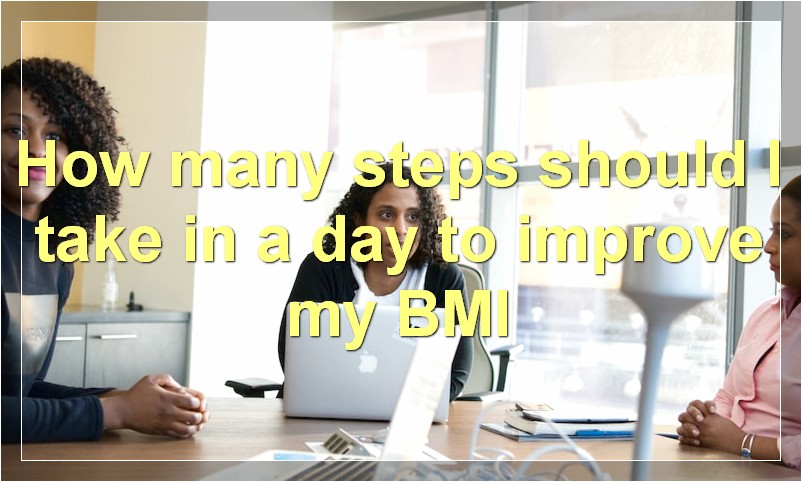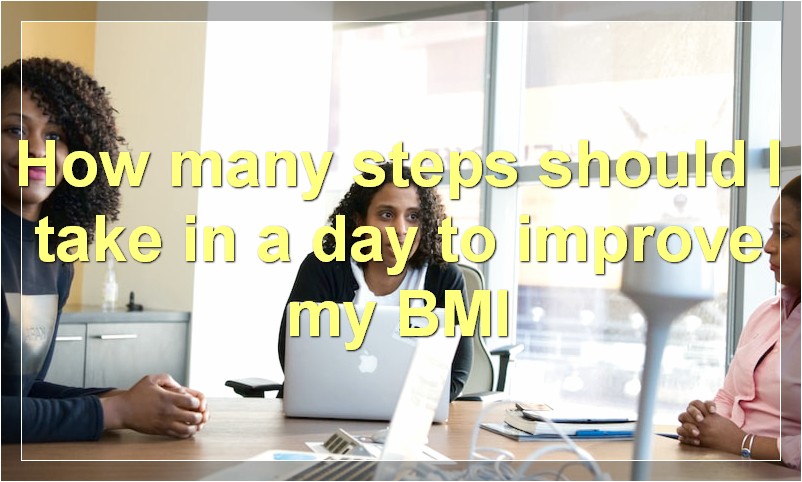If you’re looking to improve your health, one of the best things you can do is start walking. But how much should you walk, based on your body mass index (BMI)?
How much does walking impact BMI?
The BMI, or body mass index, is a way to measure whether you are at a healthy weight for your height. A high BMI can increase your risk of developing heart disease, stroke, and type 2 diabetes. Walking is a great way to help lower your BMI. In fact, just 30 minutes of walking each day can help you lose weight and lower your BMI.
How does walking help?
Walking is a low-impact form of exercise that can help you burn calories and lose weight. It is also a great way to stay active during the day. Walking can help you control your weight in two ways. First, it helps you burn calories. Second, it helps you build muscle. Muscle tissue burns more calories than fat tissue, even when you are at rest.
How much should I walk?
The amount of walking needed to impact your BMI will depend on how much you weigh and how active you are currently. A good goal to start with is 30 minutes of walking each day. If you are not used to exercising, you may want to start with 10 minutes of walking and gradually work up to 30 minutes.
Can I walk too much?
Yes, it is possible to walk too much. If you overdo it, you may experience joint pain, fatigue, or an injury. Start slowly and increase your walking time gradually to avoid these problems.
Is walking enough exercise?
Walking is a great form of exercise, but it is not the only form of exercise you need to be healthy. You should also include other forms of physical activity in your routine such as biking, swimming, or strength training. These activities will help you maintain a healthy weight, improve your heart health, and reduce your risk of developing chronic diseases such as heart disease, stroke, and type 2 diabetes.
How many steps should I take in a day to improve my BMI?

It’s often said that to improve your health, you should aim to walk 10,000 steps a day. But is there any scientific evidence to support this claim? And if so, how many steps should you actually be taking to see an improvement in your health?
There is some evidence to suggest that taking more steps each day can help you to lose weight and improve your overall fitness levels. One study found that overweight adults who increased their daily step count by 1,000 steps (from around 5,000 to 6,000) burned more calories and lost more weight than those who didn’t increase their steps.
Another study found that increasing daily steps from 7,500 to 10,000 resulted in significant improvements in blood sugar levels, cholesterol levels, and body fat percentage.
So, if you’re looking to improve your health by walking more, aim for 10,000 steps per day. This may seem like a lot, but it’s really only about 5 miles (8 kilometers), which is doable for most people. If you can’t reach 10,000 steps per day right away, start with a smaller goal and gradually increase your step count over time.
What is the ideal bodyweight for my height and how can walking help me achieve it?
The ideal bodyweight for a person’s height can be determined using a variety of methods. The most common method is the Body Mass Index (BMI). BMI is a person’s weight in kilograms divided by their height in meters squared.
For adults, a BMI between 18.5 and 24.9 is considered healthy, while a BMI below 18.5 is considered underweight and a BMI above 24.9 is considered overweight.
Walking is a great way to help you achieve your ideal bodyweight. Walking burns calories, which can help you lose weight if you are overweight, and it can also help you maintain your weight if you are at a healthy weight.
Walking also has many other health benefits, such as reducing your risk of heart disease, stroke, and type 2 diabetes.
What are the benefits of walking for weight loss?
When it comes to weight loss, there are many different approaches that people can take. Some people opt for fad diets, while others choose to cut out certain foods from their diet. Others still might try a more traditional approach, such as exercising more or eating less.
But what about walking? Is walking a good way to lose weight?
The answer is yes! Walking is a great way to burn calories and promote weight loss. Here are some of the benefits of walking for weight loss:
1. It’s Low-Impact
One of the great things about walking is that it’s a low-impact form of exercise. This means that it’s easy on your joints and muscles, and it’s unlikely to cause injuries. This makes it an ideal form of exercise for people who are overweight or obese, as they may have trouble with other forms of exercise that are more high-impact.
2. It Can Be Done Anywhere
Another great thing about walking is that it can be done anywhere. You don’t need any special equipment or a gym membership – all you need is a good pair of shoes and you’re good to go. This makes walking a convenient form of exercise for busy people who don’t have a lot of time to spare.
3. It Burns Calories
Of course, one of the main reasons why people walk for weight loss is because it burns calories. Walking at a moderate pace can burn around 150 calories per half hour, which can add up over time. If you walk for 30 minutes every day, you could potentially burn off an extra pound every two weeks – without making any other changes to your diet or lifestyle.
4. It Boosts Your Metabolism
Walking can also help to boost your metabolism, which can further help with weight loss. A higher metabolism means that your body burns more calories at rest, which can lead to long-term weight loss.
5. It Improves Your Cardiovascular Health
In addition to promoting weight loss, walking also has other health benefits. Walking is a great form of cardiovascular exercise, which means that it helps to improve your heart health. Regular walking can help to reduce your risk of heart disease and stroke, and it can also lower your blood pressure and cholesterol levels.
So there you have it – five great reasons to start walking for weight loss! Walking is a safe, effective and convenient way to lose weight, and it has other health benefits too. So what are you waiting for? Get out there and start walking!
How long do I need to walk each day to see results on my BMI?
The Centers for Disease Control and Prevention (CDC) recommend that adults get at least 150 minutes of moderate-intensity aerobic activity or 75 minutes of vigorous-intensity aerobic activity every week (or a combination of both). That means walking at a moderate pace for about 30 minutes a day, five days a week.
But if you want to see results on your BMI, you might need to walk for longer. A study published in the American Journal of Preventive Medicine found that people who walked for at least 210 minutes a week (about 30 minutes a day, five days a week) had a significantly lower BMI than those who only got the CDC-recommended 150 minutes of weekly exercise.
So if you’re looking to see lower numbers on the BMI scale, aim to walk for at least 30 minutes each day. And remember, the more you walk, the greater the health benefits will be.
Is there a specific time of day when walking is most effective for weight loss?

There are many factors that contribute to weight loss, and when you’re trying to slim down, every little bit counts. That’s why some people swear by walking as a weight-loss strategy. But is there a specific time of day when walking is most effective for weight loss?
Let’s take a closer look at the science behind walking and weight loss to find out.
The link between walking and weight loss
Walking is a low-impact form of aerobic exercise that can be easily incorporated into your daily routine. And it turns out, it may also help with weight loss.
Aerobic exercise like walking has been linked to a variety of health benefits, including improved heart health, increased lung capacity, and lower blood sugar levels (1, 2, 3).
What’s more, research has shown that adding 30 minutes of moderate-intensity aerobic exercise to your daily routine can help you lose weight and keep it off in the long term (4).
One study even found that participants who did brisk walking for 35 minutes a day lost an average of 8.6 pounds (3.9 kg) over a period of 12 weeks — without making any other changes to their diet or lifestyle (5).
Another study showed that postmenopausal women who walked for an hour a day five days per week lost an average of 5% of their body weight over the course of a year, without making any other changes to their diet or lifestyle (6).
So, if you’re looking to lose weight, walking may be a helpful strategy — especially if you make it a regular part of your routine.
When is the best time to walk for weight loss?
While any form of exercise can be beneficial when it comes to weight loss, there may be certain times of day when walking is particularly effective.
One small study showed that participants who walked after eating breakfast burned more calories throughout the day than those who didn’t walk (7).
Another study found that participants who did moderate-intensity aerobic exercise like walking in the morning had lower levels of hunger and ate fewer calories throughout the day than those who exercised in the afternoon or evening (8).
So, if you’re looking to maximize the calorie-burning effects of walking, consider taking a stroll first thing in the morning or right after breakfast.
How much should you walk for weight loss?
The amount of walking you need to do for weight loss depends on your current weight, fitness level, and overall health. However, most experts recommend starting with moderate-intensity aerobic exercise like walking for 30 minutes a day, five days per week (9).
If 30 minutes feels like too much at first, you can start with shorter 10-minute walks and gradually work up to longer sessions. The important thing is to be consistent and make walking a part of your daily routine.
Regardless of when you walk or how much you walk, remember that adding any form of physical activity to your daily routine can help support your weight-loss goals. So get out there and enjoy the benefits of Walking!
Can I eat whatever I want as long as I walk enough each day?
We all know that exercise is important for our health. We’re told to get 150 minutes of moderate activity or 75 minutes of vigorous activity a week. And we know that what we eat has an impact on our health. So, it stands to reason that the combination of the two would have an even greater impact on our health, right?
Unfortunately, it’s not quite that simple. Walking is a great form of exercise and has many benefits, but it doesn’t offset the effects of an unhealthy diet.
A study published in the journal PLOS Medicine found that people who walk briskly for at least 30 minutes a day can offset some of the health risks of being sedentary, but they cannot offset the health risks of an unhealthy diet.
The study looked at data from more than 334,000 European men and women. The participants were followed for an average of 12 years. The researchers found that people who met the guidelines for both moderate exercise and a healthy diet had a 33% lower risk of dying during the study period than people who met neither guideline.
People who met only the exercise guideline had a 27% lower risk of dying than sedentary people, and people who met only the dietary guideline had a 23% lower risk of dying than those who ate an unhealthy diet.
So, while you can’t eat whatever you want and offset the effects with exercise, you can make small changes to your diet and see big benefits. Try adding more fruits and vegetables to your diet and reducing your intake of processed foods. And make sure to get moving – every little bit counts!
How will I know if walking is helping me lose weight?
If you are looking to lose weight, there are a few things you can do to help gauge whether or not walking is having the desired effect. First and foremost, you should keep track of your starting weight so that you have a baseline to compare against as you go along. Additionally, it can be helpful to take measurements of your waist, hips, and thighs so that you can more easily see any changes in your body composition.
Another good way to gauge the effectiveness of walking for weight loss is to pay attention to how your clothes fit. If you notice that your pants are starting to feel a bit looser, or that you can button up your shirt with ease, these are signs that you are losing body fat. Finally, monitor your energy levels throughout the day. If you find that you have more energy after taking a brisk walk, this is another indication that walking is helping you to lose weight.
Should I walk at a slow or fast pace to burn more calories?
When it comes to burning calories, how you walk matters. Walking at a slower pace may seem like it’s not doing much, but it actually has a higher calorie burn than walking at a brisk pace. And, if you want to up the ante, you can even add in some inclines to really get your heart rate going and those calorie burning benefits.
What are some other things I can do to lower my BMI?
“What are some other things I can do to lower my BMI?” This is a question that we get a lot here at LowerYourBMI.com, and it’s a great question! There are a lot of things that you can do to lower your BMI, and we’re going to go over some of them here.
First, let’s start with the basics: what is BMI? BMI stands for Body Mass Index, and it’s a way of measuring whether or not you are overweight or obese. It’s calculated by taking your weight in kilograms and dividing it by your height in meters squared. If your BMI is over 25, you are considered overweight, and if it’s over 30, you are considered obese.
There are a lot of different ways to lower your BMI. One of the most obvious ways is to lose weight, but there are other things you can do as well. For example, if you are currently not very active, you can start working out and getting more exercise. This will help to increase your muscle mass, which will in turn lower your BMI.
Another great way to lower your BMI is to eat more healthy foods. This includes fruits and vegetables, lean protein, whole grains, and healthy fats. Avoiding processed foods, sugary drinks, and excessive amounts of saturated and unhealthy fats will also help you to lower your BMI.
Finally, if you smoke cigarettes or drink alcohol excessively, quitting these habits will also help you to lower your BMI. Smoking and drinking can both lead to weight gain, so kicking these habits will be beneficial in more ways than one.
So there you have it! These are just a few of the many things you can do to lower your BMI. If you’re looking to lose weight and improve your overall health, implementing some or all of these tips will definitely help you to reach your goals.




